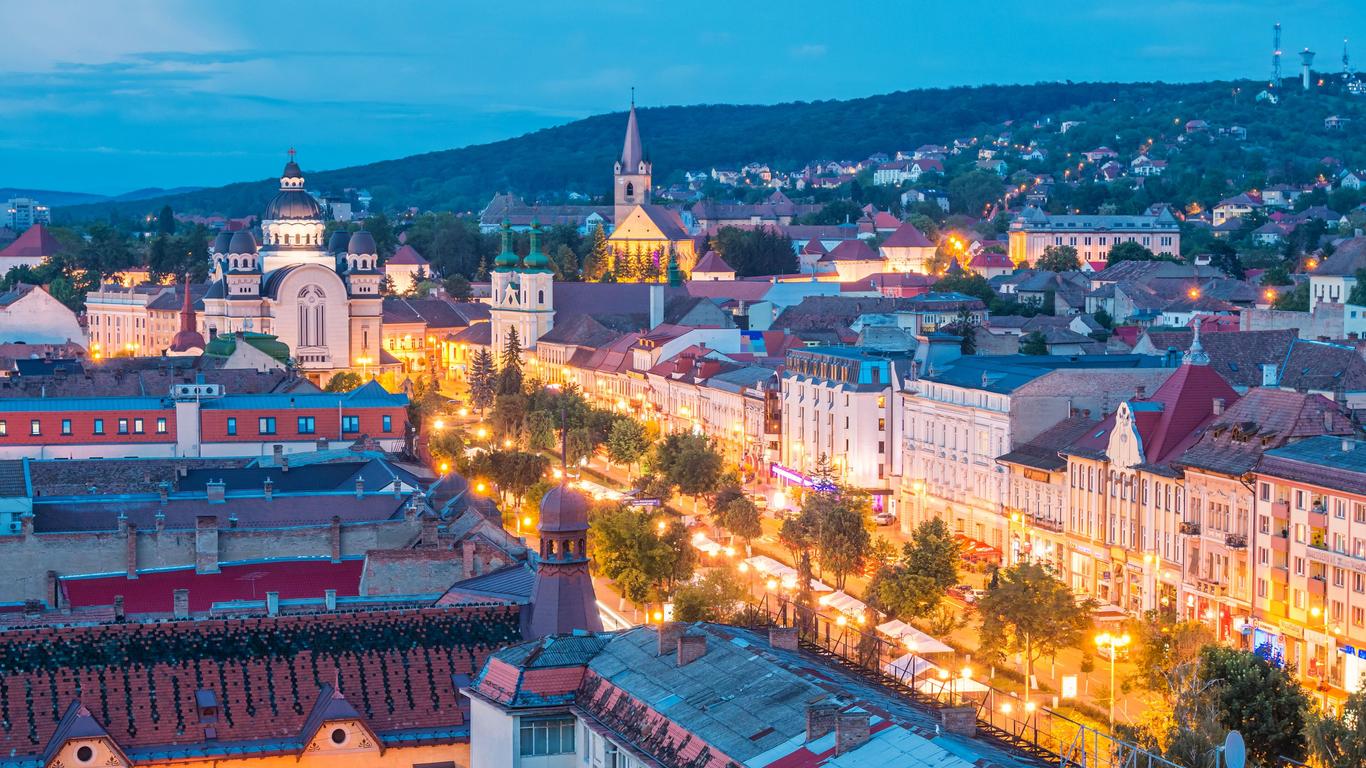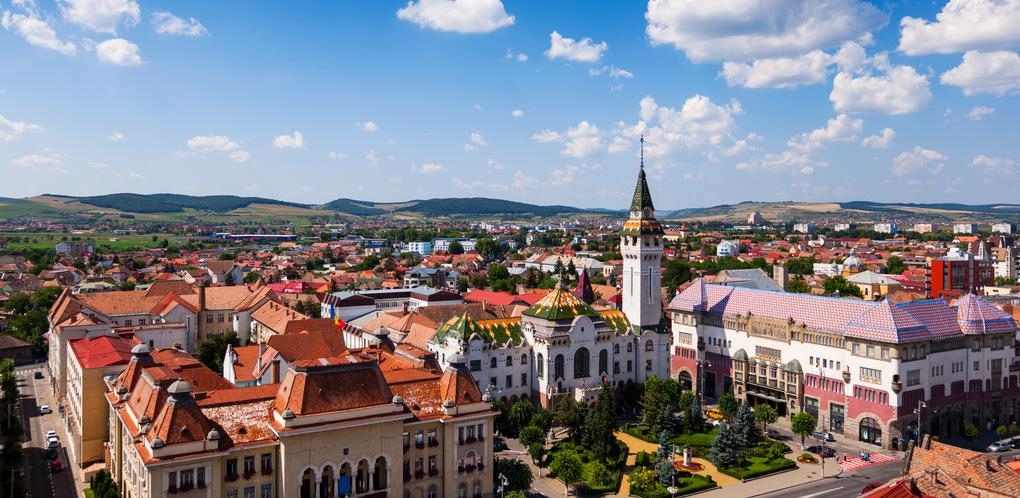
Târgu Mureş travel guide
Târgu Mureş Tourism | Târgu Mureş Guide
You're Going to Love Târgu Mureş
Târgu Mureş is a melting pot of Romanian and Hungarian cultures, featuring remains of the Neolithic, Bronze, and Metal Ages.

The Piata Trandafirilor features cafes, restaurants, churches, and Medieval monuments. The Culture Palace houses several local museums.
Top 5 Reasons to Visit Târgu Mureş
1. Ancient Culture
Though the city dates back to 1332, after the Mongol invasion, there is evidence that shows life since the Neolithic. In the 1300s the Szekler Market appeared, followed by the first guilds in the 15th century.
2. Medieval Architecture
From the Apollo Palace, a late Baroque building built in 1820, to the Târgu Mureş Fortress, begun in 1492, with a Franciscan monastery and church, Târgu Mureş features stunning examples of Medieval construction.
3. Guided Walks
Guided walking tours showcase historical landmarks and events of the Mureş Valley.
4. Jazz Festival
The annual International Youth Jazz Competition and Festival in May features cultural activities, a student competition, and jazz concerts from internationally renowned artists.
5. Transylvanian Cuisine
Try typical Romanian kolozsvari-style stuffed cabbage, paprika mushrooms, and stewed beef at Laci Csarda, a Transylvanian restaurant featuring live music.
What to do in Târgu Mureş
1. Art Deco Splendor That Makes You Hungary For More
Built just before World War One as a center for Hungarian culture in the Transylvanian region, the Culture Palace remains the epicenter for artistic and musical life in modern Târgu Mureș. The building itself is a delight, with Art Deco decorative features like exterior tiling and gorgeous windows, as well as the Hall of Mirrors, featuring scenes from Hungarian folklore. A tour is absolutely essential but check the schedule for concerts, as classical, folk and pop events at the Palace are well worth attending.
2. A Portal Back To Peasant Life
While the name "Ethnographic Museum" conjures up stuffy, lifeless displays of folk costumes, that's far from the reality of this engaging attraction. For one thing, the curators have gone out of their way to make the museum an audio-visual experience, conjuring up immersive everyday scenes from historic Transylvania. Unlike some similar institutions, you really get a feel for the dilemmas faced by peasants and townsfolk under foreign rule - and a few hours of entertainment at the same time.
3. Târgu Mureș Fascinating Fortress
First built in the year that Columbus reached the Americas, Târgu Mureș' citadel was expanded dramatically in the early 17th century, but its robust bastions couldn't prevent an Austrian conquest a couple of hundred years later. Still, the castle is a magnificent work of defensive architecture, and a joy to explore. See where defenders poured boiling oil onto their assailants and set traps to pin down attackers, and get a sense for the history of the place at the neatly presented museum. In the summer, the courtyard is also an atmospheric venue for historical events and music, so you may be in luck when you visit.
4. Cool Off When Romania's Roasting
Transylvania can be a pretty hot place in high summer, making sight-seeing challenging - even for seasoned travelers. But just a mile or two north of the city center, Complexul Weekend offers the perfect answer. This recreation complex (hence the name) is centered around a series of pools, with slides and spaces for kids, as well as beach activities like sunbathing and volleyball. So when you head to the city, don't forget to pack some swimwear. The water's incredibly inviting on a sweltering hot day.
5. Medieval Romance A Few Miles Up The River
Located around 20 miles north of Târgu Mureș along the Mures River, Reghin is a little medieval gem, and definitely worth making a day trip. The town's Gothic church is home to Latin inscriptions that are almost 1,000 years old, while there's a similarly ancient Romanesque church to visit as well. But the appeal of Reghin goes beyond elegant religious architecture. In the town center, the wrought iron balconies of the house-fronts are typically Transylvanian (and charming), and the riverfront is a great place to take an afternoon stroll.
1. Art Deco Splendor That Makes You Hungary For More
Built just before World War One as a center for Hungarian culture in the Transylvanian region, the Culture Palace remains the epicenter for artistic and musical life in modern Târgu Mureș. The building itself is a delight, with Art Deco decorative features like exterior tiling and gorgeous windows, as well as the Hall of Mirrors, featuring scenes from Hungarian folklore. A tour is absolutely essential but check the schedule for concerts, as classical, folk and pop events at the Palace are well worth attending.
2. A Portal Back To Peasant Life
While the name "Ethnographic Museum" conjures up stuffy, lifeless displays of folk costumes, that's far from the reality of this engaging attraction. For one thing, the curators have gone out of their way to make the museum an audio-visual experience, conjuring up immersive everyday scenes from historic Transylvania. Unlike some similar institutions, you really get a feel for the dilemmas faced by peasants and townsfolk under foreign rule - and a few hours of entertainment at the same time.
3. Târgu Mureș Fascinating Fortress
First built in the year that Columbus reached the Americas, Târgu Mureș' citadel was expanded dramatically in the early 17th century, but its robust bastions couldn't prevent an Austrian conquest a couple of hundred years later. Still, the castle is a magnificent work of defensive architecture, and a joy to explore. See where defenders poured boiling oil onto their assailants and set traps to pin down attackers, and get a sense for the history of the place at the neatly presented museum. In the summer, the courtyard is also an atmospheric venue for historical events and music, so you may be in luck when you visit.
4. Cool Off When Romania's Roasting
Transylvania can be a pretty hot place in high summer, making sight-seeing challenging - even for seasoned travelers. But just a mile or two north of the city center, Complexul Weekend offers the perfect answer. This recreation complex (hence the name) is centered around a series of pools, with slides and spaces for kids, as well as beach activities like sunbathing and volleyball. So when you head to the city, don't forget to pack some swimwear. The water's incredibly inviting on a sweltering hot day.
5. Medieval Romance A Few Miles Up The River
Located around 20 miles north of Târgu Mureș along the Mures River, Reghin is a little medieval gem, and definitely worth making a day trip. The town's Gothic church is home to Latin inscriptions that are almost 1,000 years old, while there's a similarly ancient Romanesque church to visit as well. But the appeal of Reghin goes beyond elegant religious architecture. In the town center, the wrought iron balconies of the house-fronts are typically Transylvanian (and charming), and the riverfront is a great place to take an afternoon stroll.
Where to Eat in Târgu Mureş
Emma serves Romanian schnitzel, paprika chicken, and vegetarian chili. Lunch specials average RON13. Dona specializes in pizza, meat, and fish dishes and pasta. Entrees average RON20.
When to visit Târgu Mureş
The best time to visit Târgu Mureş is between May and September when temperatures average 73 to 84 degrees.
How to Get to Târgu Mureş
Plane
The Târgu Mureş International Airport (TGM), nine miles from downtown, connects directly to Copenhagen, Barcelona, Budapest, Dortmund, London, Madrid, Milan, Paris, and Rome. A shuttle bus from the airport averages RON7 and a taxi is RON40.
Train
There are several daily trains from Brasov and Timisoara, a 6.5-hour trip, and from Bucharest, a 9.5-hour trip. There is also a daily train from Budapest, a nine-hour trip starting at RON81.
Car
From Budapest you can reach Târgu Mureş in eight hours on the M3, the DN1/E60, or the A1.
Bus
There are buses from Brasov every two hours, and from Budapest four times a week. Prices from Brasov start at RON16 and from Budapest at RON247.
Airlines serving Târgu Mureş
Where to stay in Târgu Mureş
City Center - featuring imposing Medieval architecture, museums, churches, shops, cafes, and restaurants, the Târgu Mureş city center is a showcase for Romanian and Hungarian culture.
Popular Neighborhoods in Târgu Mureş
Cornesti - home to the Plateau and the zoo, Cornesti, over Târgu Mureş, is a great spot for panoramic views of the city and the Mureş river valley. The zoo houses primates, large cats, elephants, zebras, and bears, among others.
Reghin - 19 miles from Târgu Mureş is Reghin, renowned for its violin craftsmanship. Its central square, Piata Petru Maior, features vibrant 19th-century architecture adorned with wrought-iron balconies.
Where to stay in popular areas of Târgu Mureş
Most booked hotels in Târgu Mureş
How to Get Around Târgu Mureş
The Cost of Living in Târgu Mureş
Shopping Streets
The Mureş Mall, near the city center, features five floors of retail shopping. The Promenada Mall, on the outskirts of Târgu Mureş, has chain stores, a movie theater, and a supermarket.
Groceries and Other
Auchan, a hypermarket, carries food, housewares, beauty products, and clothing. Darina is a local supermarket chain, which carries staples. The cost of living in Târgu Mureş is relatively inexpensive. A gallon of milk averages RON16.27 and a loaf of bread is RON1.82.
